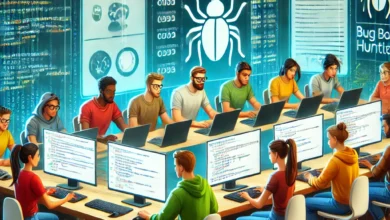Building Your Cybersecurity Playground: Crafting the Perfect Lab
From understanding its significance to hands-on implementation, dive deep into creating a personal cybersecurity lab for skill enhancement.

As with many things in life, theory and practice in cybersecurity are two very different things. While theoretical knowledge provides the foundation, hands-on experience is what really cements this knowledge and expands your skills. For many aspiring cybersecurity professionals and bug bounty hunters, setting up a personal cybersecurity lab can be an excellent way to gain this practical experience. This article will guide you through the basics of setting up your first cybersecurity lab.
The Benefits of a Cybersecurity Lab
A cybersecurity lab provides a controlled environment where you can explore and learn without causing harm to real systems or running afoul of legal boundaries. It allows you to:
1. Experiment Safely: You can create scenarios that involve malicious software, network intrusions, and other security incidents, then observe how they unfold and how to combat them.
2. Apply Knowledge: It provides an avenue to apply what you’ve learned theoretically and see how it works in practice.
3. Develop Problem-Solving Skills: Each challenge you create and solve in your lab helps develop your analytical and problem-solving skills.
4. Test New Tools and Techniques: The lab environment is perfect for testing new cybersecurity tools and techniques before using them in real-life scenarios.
Setting Up Your First Cybersecurity Lab
Setting up your lab doesn’t necessarily require high-end equipment or a significant financial investment. With the right resources, you can set up a functional cybersecurity lab using a standard personal computer. Here’s a basic guide to getting started:
1. Choose Your Hardware: You don’t need a supercomputer to start a cybersecurity lab. A decently powerful computer can run multiple virtual machines for your lab environment. If possible, consider a system with a good amount of RAM and a multi-core processor to handle multiple tasks smoothly.
2. Install a Hypervisor: A hypervisor allows you to create and run multiple virtual machines (VMs) on a single physical machine. There are several good options available, like VMware and VirtualBox, which offer free versions.
3. Set up Virtual Machines: Install various operating systems on your VMs. These systems will act as your test environments. You might consider a mix of Windows, Linux, and maybe even some MacOS.
4. Load Necessary Tools: Each VM should be equipped with the necessary tools for your experiments. This could include software for penetration testing (like Metasploit), network sniffing (like Wireshark), and vulnerability scanning (like Nessus).
5. Practice Safe Testing: When running potentially harmful scripts or investigating malware, it’s essential to isolate the VMs to prevent accidental infections. Always revert to a known safe state after each testing session.
6. Set Challenges: Start by recreating known vulnerabilities or use platforms like Hack The Box or VulnHub to get pre-made vulnerable machines.
A cybersecurity lab is an ongoing project that you can grow and adapt as you develop your skills. The beauty of a personal lab is that it can evolve with you, expanding as you learn more about different threats and the techniques to counteract them.
Remember, the goal is not to rush the set up but to create an environment that allows for continuous learning and experimentation. This investment of time and resources can significantly boost your practical knowledge and give you a considerable advantage in your bug bounty-hunting endeavors.
Diving Deeper into Your Cybersecurity Lab
Advanced Configurations Once you’re comfortable with your basic lab setup, consider delving into advanced configurations. This could involve:
- Networking Configurations: Simulate real-world networking scenarios by setting up different network types, like DMZs and VLANs, or even simulate WAN connections. This allows you to practice network segmentation, firewall configurations, and VPN setups.
- Active Directory Environment: If you’re focusing on enterprise security, setting up an Active Directory (AD) environment will be invaluable. AD is used in countless organizations, and understanding its security aspects can be a game-changer.
- Malware Analysis: Consider setting up a dedicated VM for malware analysis. Equip it with tools like IDA Pro, OllyDbg, and others to dissect malicious software and understand its inner workings.
Continual Learning in Your Lab Your lab is more than just a set of tools and VMs; it’s a continuous learning environment. To make the most of it:
- Follow Online Tutorials: There are numerous online resources that provide walkthroughs of various cyber challenges. Use these as a guide to set up scenarios in your lab and then attempt to solve them.
- Regularly Update Your Tools: The cybersecurity landscape evolves rapidly. Regularly updating your tools ensures you’re working with the latest techniques and can recognize and address new vulnerabilities.
- Participate in Capture The Flag (CTF) Competitions: These competitions present a set of cybersecurity challenges and can be an excellent way to test your skills. Many CTFs offer virtual environments that you can download and set up in your lab for practice.
The Social Aspect of Cybersecurity Cybersecurity isn’t just about individual skill; it’s a community effort. As you develop your lab:
- Join Forums and Communities: Websites like Stack Exchange’s Information Security, Reddit’s r/netsec, and others can be great places to discuss challenges, share knowledge, and learn from other enthusiasts.
- Share Your Findings: If you discover something interesting or unique in your lab, consider writing a blog post or creating a tutorial. This not only contributes to the community but also cements your understanding of the topic.
- Collaborate: Consider teaming up with friends or colleagues. You can set challenges for each other, collaborate on complex scenarios, or even simulate multi-agent attacks and defenses.
Wrapping Up The journey into cybersecurity is exciting, challenging, and ever-evolving. Your personal lab is a reflection of this journey, growing and adapting with every new skill you acquire and every challenge you overcome. It’s a sandbox that allows for mistakes, retries, and, most importantly, endless learning. Whether you’re an aspiring bug bounty hunter, a cybersecurity professional, or just an enthusiast, a well-equipped lab can be your most valuable asset. Remember, in the world of cybersecurity, practical experience often speaks louder than theory, so get hands-on and keep exploring!




